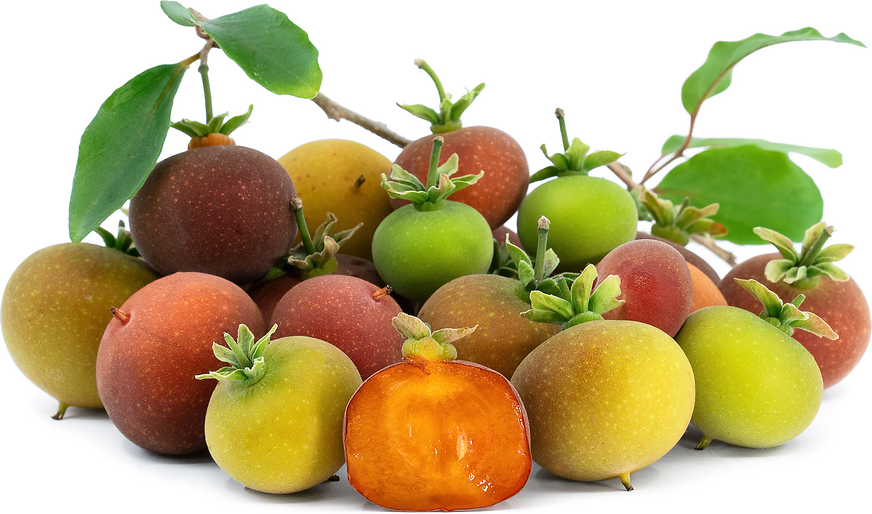


Ceylon Gooseberries
Estimated Inventory, lb : 0
Description/Taste
Ceylon gooseberries are small tree fruits shaped like blueberries. They are 1 to 2.5 centimeters in diameter, with tight skin that is dark brown-orange with lighter orange and yellow sections when unripe, and a deep speckled maroon-purple when mature. Their skin is covered with short green-gray velvety hairs that make for a peculiar mouthfeel, often requiring removal before consumption. Their juicy flesh is purple-red and extremely acidic. Each fruit contains 8 to 12 long, edible hairy seeds that are approximately 6 millimeters long. Ceylon gooseberries have a flavor that varies from sweet to puckeringly sour and astringent, with a taste akin to cranberries, lemons, honey, papayas, and apricots. The fruit is most palatable when slightly overripe and wrinkled, as this is when the sugars are at their highest concentration.
Seasons/Availability
Ceylon gooseberries are available late spring to early summer and fall.
Current Facts
Botanically, Ceylon gooseberries are known as Dovyalis hebecarpa and belong to the Salicaceae family along with the weeping willow and pussy willow. These berries are also known as Ketembilla and, with a nod to their flavor, Tropical apricot. In Cuba and throughout Central America, they are referred to as Iberia. They also go by Kei apple, Kitambilla, and Puerto Rican cranberries. Native to Sri Lanka and Southern India, Ceylon gooseberry trees have both culinary and ornamental value, used for their fruits and as a decorative landscaping tree to protect from windy weather. This tree grows up to 6 meters tall with a thirty-foot spread, prolifically producing around 40 kilograms of fruit each year.
Nutritional Value
Like other dark-skinned fruits, Ceylon gooseberries boast high amounts of antioxidants, polyphenols, and anthocyanins. Antioxidants help protect the body from oxidative stress and free radical damage, which can lead to chronic diseases and aging. Ceylon gooseberries' polyphenol micronutrients may improve digestion, brain health, gut health, and insulin sensitivity as well as lower blood pressure and reduce bad cholesterol levels. The anthocyanins in Ceylon goosberries are known for regulating blood sugar, improving vision and immune function, reducing inflammation and oxidative stress, and alleviating arthritis and inflammatory bowel disease.
Applications
Ceylon gooseberries are often used for jellies and compotes rather than raw because of their bitter, sour taste. Their astringent nature is balanced out when sweetened with sugar. When moderately underripe, they are popularly mixed with other fruits such as papaya, guava, and apple to create blended fruit butter and jams. This fruit can serve as a sour substitute in cranberry recipes. Warming spices such as cinnamon, anise, and nutmeg complement Ceylon gooseberries and can be used to tone down their sour flavor profile. Hawaiians employ the berry to create salad dressings, dipping sauces, purées, pickles, barbeque sauces, chutneys, wines, and brandy. The berry is typically reduced into syrup and used as a base for dressings and sauces. They are commonly pressed into juice, which is done by scooping flesh from the skin and blending it with sugar and water. The mixture is then strained through a fine sieve to remove seeds and create an even texture. Berries should be ripened at room temperature and placed into the refridgerator when fully purple, as they can quickly ferment.
Ethnic/Cultural Info
During World War II, Floridians cultivated Ceylon gooseberries, taking advantage of their unique taste and high pectin content, which makes them ideal for preserving. The fruits were highly valued for their ability to be transformed into delicious and long-lasting products, providing a valuable source of nutrition and flavor during the challenging war years when fresh produce was less available. In addition to jams and juices, Ceylon gooseberries were also used in making syrups sauces, contributing to a versatile array of decadent and sweet preserved foods that could be enjoyed during times of uncertainty and scarcity.
Geography/History
Ceylon gooseberries are native to Sri Lanka, formerly known as Ceylon. Despite disliking their flavor, Doctor David Fairchild brought these berries to the United States around the turn of the 20th century. From there, they traveled to Hawaii where they were intended for use as a shrub in hedgerows and wound up becoming an important part of the islands' economy and cuisine. Ceylon gooseberries are also grown in Puerto Rico, where they have been naturalized in the country’s landscape, as well as limited areas of Cuba, Honduras, South Africa, Florida, California, South India, the Philippines, and Israel. In these regions, Ceylon gooseberries are more often used as an ornamental hedge plant or sown in gardens than sold commercially. Outisde of these regions, Ceylon gooseberries are an obscure fruit.




